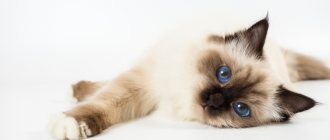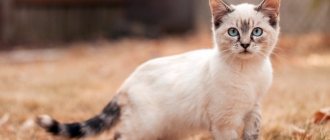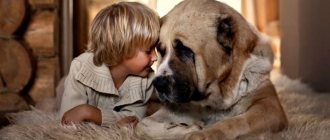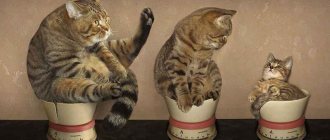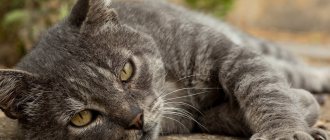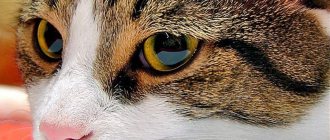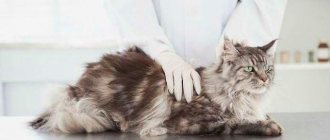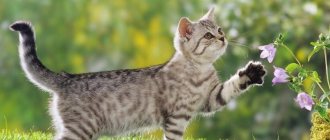Why do you need to know the age of cats?
Having found out how old your pet is, you can properly adjust its care, balance its diet, and better monitor its health. It is impossible not to take into account changes in years, because this will have a bad effect on the standard of living of your mustachioed friend. Why else might such knowledge be useful:
- Determine the level of physical activity, the intensity of which decreases with age. Excessive play with an elderly person will have a bad effect on the joints and cardiovascular system. But for younger people, lack of activity will negatively affect physical development or lead to dangerous obesity.
- The cat's health is monitored in accordance with physiological changes. For example, only older individuals are susceptible to cataracts. Therefore, caring for mature pets should be more thorough.
- The selection of diet must be correlated with the characteristics of the period of life. Nutrition must meet the needs of the body. For example, older cats find it difficult to eat dry food because their teeth have worn out and become more brittle. They are no longer adapted to rough food.
Knowing the degree of maturity, it is not difficult to help your mustachioed friend develop fully and provide him with good care and proper nutrition. The quality of life and attention of the owner will prolong the cat’s life.
By external signs
The approximate age of cats can be determined by the type of animal. It's easy to understand where the kitten is. If the animal is an adult, this is more difficult to do.
The condition of the coat indicates age. If it is healthy and shiny, then most likely the cat is no more than 6 years old. An assessment of behavior and emotional development will provide more information. The most active are teenagers aged 1-2 years. Adults are more passive.
Periods of a pet's life
According to research by zoological scientists, the life of a mustachioed friend goes through different stages. Each of them is characterized by its own physiological, behavioral and psychological characteristics. There are 6 stages of cat age:
- Childhood
lasts from birth to six months. This is a time of rapid growth, as well as formation until the onset of puberty.
- Youth
– period from 6 months to 2 years. This is the stage of preparing the body for adulthood. The growth of the mustachioed friend continues, but at a reduced pace.
- Heyday
– time from 2 to 7 years. This is the peak of increased physical and mental activity: the pet has a strong skeleton, healthy teeth and beautiful coat.
- Maturity
– stage from 7 to 11 years. Then a slight decrease in physical activity begins, but in general the cat’s age is not so noticeable.
- Elderly age
– stage from 11 to 15 years. Vitality is gradually lost. The appearance and quality of fur, claws, and teeth deteriorate. The first health problems appear.
- Old age
. After 15 years, a decrease in various types of activity is clearly expressed, sleep time increases, and an increased risk of various diseases arises.
This division into stages becomes fundamental when understanding the degree of maturity of a cat. Awareness helps in proper care and maintenance. Veterinarians quite easily determine the age of a cat based on physiological data and behavioral characteristics of each period.
Periods of human development
First comes the period of infancy. The newborn is completely dependent on the parents, cannot walk, talk, and does not eat adult food. Then comes childhood. The child grows, gains weight, learns to read and write, explores the world, goes to school, makes friends. Boys and girls choose a profession, go to college, and socialize in society. During this period, interests and life attitudes are formed, puberty occurs. An adult works and starts a family. In old age, health-related issues often arise, visual acuity and senses become dull, and activity decreases.
Determining the number of years lived
It is difficult for an inexperienced owner to determine the age of a cat without the help of a specialist. An experienced breeder is able to accurately indicate the age of his pet, but it would be best to show the animal to a veterinarian. The specialist will not only tell you how old the cat is, but will also paint a general picture of her condition. In veterinary practice, there are several criteria for determining the age of animals.
According to the condition of the teeth
Veterinarians can easily determine the amount of time an animal has lived by looking at its teeth. This method is effective for different individuals, from kittens to old people. This fact can be explained by the fact that the schedule for replacing baby teeth with molars is quite strict. The strength of the fangs and their color are the best indicators of not only the health of the pet, but also its maturity.
| Number of years | Condition of the oral cavity |
| 5 weeks | Baby teeth erupting |
| 6 months | Dairy products are completely replaced by permanent indigenous ones. |
| 1 year | The canines should be in the best condition, white and strong |
| 1.5 years | The incisors on the lower jaw begin to wear off |
| 2 years | The enamel becomes yellow in color and traces of deposits appear |
| 4-5 years | The incisors on the lower jaw wear away very noticeably |
| 6 years | Abrasions on the fangs begin to appear, dark spots appear on the enamel |
| 7 years | The surviving incisors are completely worn away. Fangs in poor condition |
| 10 years | Half of the teeth are lost |
| 13-15 years old | Fangs fall out |
Table 1. Age of cats according to dental condition
The influence of time lived on the condition of the oral cavity is very noticeable. Unfortunately, the owner rarely pays attention to this and is in no hurry to change the pet’s diet when necessary. It would be a good idea to make periodic visits to a veterinarian-dentist, who will assess the condition of the oral cavity and tell you how to prevent teeth from wearing out too early.
According to the condition of the coat
The pet's appearance helps determine a cat's age. This method of definition is the most understandable for a non-specialist. However, veterinarians do not consider this method to be unambiguous, because environmental factors and living conditions can affect the condition of the coat and skin. Good care plus a balanced diet allows you to maintain an excellent appearance even in older individuals. There are only generalized signs that help determine the degree of maturity of a pet.
| Number of years | Type of coat |
| 0-1 | Hair is soft and shiny. There are no signs of baldness or tangles |
| 1-7 | A healthy individual has fur in excellent condition: smooth, fluffy, with a good pattern. Gray hair is completely absent |
| 8-15 | The hair is dull and thin. Tangles and bald spots often appear |
Table 2. Age of cats according to coat condition
This method of determination has many disadvantages. Representatives of some breeds have no hair at all or their hair is quite short and coarse. This makes it much more difficult to figure out changes over the years.
According to changes in the musculoskeletal system
Proper distribution of physical activity helps maintain energy and lightness until old age. In this regard, changes in the skeleton do not become a sign that the owner pays attention to. However, for a veterinarian, bones and muscles are the best indicator of a pet's maturity.
In mature individuals, the muscles are developed in proportion to the skeleton. After final puberty, the pet acquires the characteristic features of the breed’s exterior. In addition, a mature musculoskeletal system has a number of common features:
- pronounced muscle relief;
- gracefulness and ease of movement;
- increased activity, endurance.
In older animals, after 8 years of life, the first signs of aging begin to appear. They are not too noticeable, but already create inconvenience for an active individual. The changes are clearly visible in short-haired breeds. Such manifestations include:
- Sunken spine, protruding shoulder blades.
- Lack of ease of movement. Sometimes they are given to an elderly pet with great effort.
- The volume of muscle tissue decreases noticeably, and the remaining muscles become decrepit.
Aging felines often suffer from thinness. If the pet has excess fat, then some criteria are noticeably smoothed out. The most obvious sign of this is difficulty moving.
According to eye condition
The eyes are not the most accurate way to determine old age, since noticeable changes only begin in older animals. Until the age of 10, the eyes of kittens and mature cats are almost no different.
An indicator of old age is the iris, which can be:
- cloudy;
- covered with patches;
- with uneven, blurry edges;
- with faded color.
An eyesore also indicates that the cat's youth has passed. A non-obvious sign is that the eye becomes very wet, but this does not happen in every older cat.
How to determine the age of a kitten
The kitten can be weighed, but this figure will not provide accurate information about the baby’s age. Breed and heredity play a big role here. The difference may or may not be significant; much depends on individual developmental characteristics. At birth, kittens are 10-12 cm tall (without tail), weigh about 100 g and gain up to 10-20 g daily. After 3 months of age, weight gain varies from 350-400 g to 500 g monthly.
Determine the age of a kitten by weighing
Approximate data:
- first week of life - 100-150 g;
- at 2-3 weeks - 170-220 g;
- at 4-5 weeks - 220 −250 g;
- at 7-8 weeks - 650-900 g;
- at 3 months - 1500-1900 g;
- at 4 months - 2500-3000 g;
- at 5 months - 3500-4000 g;
- at 6 months - about 4500 g, this is practically an adult animal.
If a kitten weighs less than 100 g at one week of age, this may indicate malnutrition or a developing disease. At 4-5 weeks, if there is a large deviation from the norm, the kitten must be shown to a veterinarian.
How to tell how old a kitten is by its teeth
Based on the presence of teeth and their number, you can determine the age of your pet much more accurately. It is normal for kittens under two weeks to have no teeth. Usually by 2 months all the baby teeth appear, the first ones appearing - the incisors. By the 3rd week of life, they erupt, followed by fangs (by 3-4 weeks). Those located behind the fangs - premolars - will come out by the end of the 2nd month. The upper cat's jaw has 3 premolars on each side, the lower - 2.
How to determine the age of a kitten by the presence of teeth
In the third month of life, a healthy kitten already has 26 teeth: 4 canines, 10 premolars and 12 incisors. Baby teeth are replaced by molars closer to 3 months in the same order: first the incisors, then the canines, then the premolars. The molars that are set the farthest out are the last to emerge. They, like premolars, are used by animals to chew food. The process ends completely only by 7 months, when the pet has all 30 teeth.
Important! Many people try to count the number of teeth a kitten has by touch. This should not be done; only a visual inspection can provide complete information.
Is it possible to determine the age of a kitten by its eyes?
The age of only very small fluffies is determined by their eyes, but not teenagers. In newborns they are closed, opening during the first stages of life within 2 weeks. In the 3rd week, they may still be narrow and cloudy, although some babies open their eyes completely during this period. Almost all babies have a blue tint. This will not last long, very soon, at 6-7 weeks, the color of the iris will change. In some breeds, such as Thai or Siamese, it will remain blue for life.
How to find out the age of a kitten by ears
Unfortunately, the age of only tiny kittens can be determined by their ears. In newborns, the ears are pressed to the head, the ear canals are closed, and open at the beginning of the 2nd week. By the end of the 3rd period, the shape of the ears of ordinary kittens changes, as the auricles straighten. At 3.5 weeks, the kitten reacts well to external stimuli and listens to different sounds and rustles.
For your information! Excessive fearfulness at this age is a common occurrence.
Cat to human age ratio
Experts name three methods for comparing the life periods of people and cats. Unfortunately, none of them is considered absolutely accurate, so the age of a cat by human standards is always only approximate.
First way
The starting point is 1 year. This period is the time of puberty of the animal. This age corresponds to 16 years of age. Another milestone is 2 years, at which time the formation of the pet’s character and habits ends. This happens at 24 years old by human standards. After 3 years, the pet’s maturity is determined using the formula:
x = 24 + ((number of years – 2) * 4)
For example, your cat is 6 years old. This means you need to subtract two (you get four), multiply by four (you get 16), and then add twenty-four. It turns out that a six-year-old cat, by human standards, is exactly 40 years old.
Second way
Another method is to calculate the number of years in each of the three periods of life. This method is considered more accurate than the previous one due to the detailed nature of the calculations. The degree of maturity can be determined using the following formulas:
| Number of years (z) | Formula |
| 1-5 | x = z * 7 |
| 6-11 | x = (z – 5) * 4 + 35 |
| 12-20 | x = (z – 11) * 3 + 59 |
Third way
This technique has a scientific basis and was developed by veterinarians together with zoological scientists. The basis is an indicator that takes into account the intellectual, psychological and physiological level of development, converting a cat’s age to a human age in the table.
| Number of years of the cat | Number of years of a person |
| 1 | 18-19 |
| 2 | 25 |
| 3 | 32-33 |
| 4 | 35-36 |
| 5 | 40-41 |
| 6 | 43-45 |
| 7 | 46-47 |
| 8 | 50-52 |
| 9 | 55-56 |
| 10 | 60-62 |
| 11 | 64-65 |
| 12 | 67-68 |
| 13 | 70 |
| 14 | 72-73 |
| 15 | 75 |
| 16 | 76-77 |
| 17 | 78 |
| 18 | 83 |
| 19 | 91 |
| 20 | 100 |
Table 3. Age of a cat by human standards
Despite such a detailed table, it should be remembered that an accurate comparison of two fundamentally different biological species is almost impossible. A cat's age by human standards can vary. The rate of development of human and animal organisms has few similar characteristics. Here it is worth taking into account the difference in breeds and gender differences.
Stages of growing up a cat
Infancy
Eyes of a young cat
A kitten matures much faster than a human (in a few weeks). Born absolutely helpless, blind and deaf, during this time he gets acquainted with the world and learns to walk.
A week after birth, hearing appears (the protective film falls off), and the eyes open. Vision develops gradually over several weeks. In the second week, teeth begin to emerge. In a human child, this occurs at 5-9 months.
At one month, kittens are already actively running, which is what human children do at 1-1.5 years. A 3-month-old kitten is comparable in social intelligence to a 2-year-old human child.
The table below shows the age of kittens by human standards (by month):
| Kitty | Human | Kitty | Human |
| 1 month | 5-7 months | 5 months | 9-10 |
| 2 months | 10-11 months | 6 months | 13-14 |
| 3 months | 2 | 7 months | 15 |
| 4 months | 5-6 | 8 months | 16 |
Childhood
This period is the most difficult to compare, due to the rapid growth of kittens.
At 4 months, kittens are already actively playing with their brothers and sisters, determining who is a stranger and who is their own, building relationships with their owners, and can cope without their mother with licking themselves, washing themselves, sharpening their claws, and eating.
The age of cats in the first year of life in human terms is 18, which encourages owners to take a closer look at raising their furry friend, forming only positive habits (going to the toilet in a litter box and sharpening their claws in the right place, not peeling wallpaper, not damaging furniture, do not bite, etc.).
Teenage years
A kitten at the age of 6 months, like a true teenager, begins to test the boundaries of what is permitted. Therefore, the owner must react in a timely manner and stop what is illegal. You should not forgive pranks and pampering, thinking that the kitten is still a child and its behavior will improve.
Also around this period (6-7 months), females begin to go into heat, causing a certain reaction in males. It is advisable to prevent mating, since the female is not physically ready for childbirth and especially motherhood, but she can become pregnant.
Youth
From one to two years, the pet already looks like an adult, but still behaves like a child, playing, hiding, etc. Clumsiness disappears in movements and grace appears.
Youth
During this period, the pet shows maximum strength, agility, and tirelessness. Youth lasts up to 5 years, which in human years is equal to 40. The ideal period for having healthy offspring.
Maturity
From 6 to 10 l. (about 40-55 human) the pet is calm, sometimes it can play. Problems may begin in the functioning of the kidneys, liver, and gastrointestinal tract. Unsterilized pets may suffer from hormonal imbalances.
Old age
From 10-12 l. cats are considered already elderly, although there are individuals that have lived up to 20 years. It all depends on the conditions under which the pet is kept and its health. For example, outdoor cats live up to 10, and indoor pets often live longer than 16.
There are also long-lived cats that live up to 20 years or longer. For example, the Texas cat Pushinka lived 38 years, and the cat Granpa Rex Allen lived 34 years. Both pets lived with the same owner. Their owner noted that they lived so long only thanks to their diet: bacon, eggs, broccoli, asparagus.
There is also information about the cat Lucy from England, who lived up to 43 years. Her last owner in 2015 found documents that she was born in 1972.
Is it possible to increase the lifespan of a cat?
Any owner dreams of having a furry family member to please him for as long as possible. And he has the power to do everything so that the cat lives for 15, or even 20 years. What will prolong the life of your beloved four-legged animal:
- Annual vaccination
. The kitten is vaccinated in the first 2-3 months of life and then the procedure is repeated every year. This will protect both your indoor and outdoor cats from the most terrible viruses with a high fatality rate.
- Routine examination by a veterinarian
. Non-pedigreed cats get sick less, so they can be shown to the veterinarian during vaccination once a year - just ask the doctor about this. Pedigree animals and animals with chronic diseases require more frequent visits to the veterinary clinic - the frequency will be determined by the veterinarian himself.
- Sterilization and castration
. If you do not plan to breed kittens, be sure to sterilize your pet - this will help avoid many problems, including diseases of the genitourinary system and mental disorders.
- Attention to any changes in your pet's behavior
. Has your cat started drinking a lot? Stopped sleeping in your favorite chair? Is he limping? Are there strange discharges? Even such little things require close attention from the owner. The first action in case of suspicion is to call the veterinarian, he will tell you whether you need to take the animal to the clinic or if you can watch it at home.
- Purity
- the key to health. Cats groom themselves, but this is not enough to maintain hygiene. For example, long-haired breeds cannot cope with caring for a luxurious fur coat, and it must be combed regularly to prevent parasites or skin diseases. It is necessary to thoroughly rinse the cat's food and water bowls, disinfect the trays, and wash the bedding.
- Nutrition
must be maintained at a high level. It is not so important what you feed your cat - the main thing is that the selected diet suits it. A young cat will benefit from both natural food and high-quality dry food. But kittens and elderly individuals require a special menu, which cannot be cheap. Therefore, before getting a cat, think about the fact that in old age, in 95% of cases, it will require greater expenses than in youth.
- Treat your cat like a family member
. Consider the nature of the pet and its needs. If she doesn't tolerate loneliness well, you shouldn't leave her in the apartment all day. And on the contrary - if the kitty loves isolation, respect her personal space. There are many such points, and if you do not pay attention to the psychological state of the animal, it will constantly be sick and will not live very long.
This is not a complete list of what a loving owner can do. The most important thing is to be attentive and patient, treating your pet as a younger member of the family. Then he will live very long and happily.
How to extend the life of a cat
The following factors influence a cat's lifespan:
- Self-walking. Vagrancy should be avoided; in urban conditions, letting a cat out of the house unattended is doubly dangerous. Such walks often end in injury, incurable infection (viral leukemia, immunodeficiency) and death. It is better to fence the dacha area so that the cat cannot leave its boundaries, or equip it with a spacious enclosure.
- Nutrition. The diet should be fresh, balanced, and appropriate to the age of the animal. Industrial feed should be chosen at least premium class. If ready-made food is not suitable for some reason, the cat should be prepared separately; you should not feed it food from the human table.
- Regular vaccination. It is necessary to vaccinate all pets, including those who do not leave the house (the causative agent of the infection can come from the outside, from the owner’s shoes or clothes).
- Control of reproduction. It is best to neuter your pet. In fertile cats, do not give birth more often than once every 1-2 years (at the age of no earlier than 2 years and no later than 6-7).
- Veterinary control. At the first sign of illness, your pet should be seen by a doctor. For older cats, an annual preventive examination is recommended, including a general examination, blood, urine and feces tests, and consultation with a cardiologist.
- Living conditions. The cat should have a resting place in the house, where no one will disturb it, and enough toys for active pastime. The litter tray must be placed in a secluded place and kept clean.
Compliance with the rules of keeping, love, creating a calm and friendly atmosphere in the house is the key to a happy and long life for your pet.
Long-livers in the world of cats
You always want to believe that a pet will become a happy exception and turn into the smartest/obedient/beautiful/healthy/long-living cat in the world. And indeed, this sometimes happens - and not so rarely. But some cases are like a miracle.
Long-lived breeds
Before getting a purebred cat, it is advisable to find out what diseases it is predisposed to and how many years it lives on average. Breeds that can easily live 18-20 years include:
- Savannahs (one of the most expensive cats);
- Siamese cats;
- Manx;
- Persian cats;
- rexes (Cornish, Devon and others);
- Egyptian Mau;
- Burmese;
- Russians are blue.
Their life expectancy is due to good genetics and good health. However, this list can include the most common “breed” in the world – an ordinary yard cat. Outbred mustachios easily break records, living up to 20 years with good care and the absence of diseases.
How long do domestic cats live?
The average life expectancy of a domestic cat is 15-16 years, provided that the pet is cared for, monitored and promptly shown to a veterinarian. When compared with stray cats, who live on average 5-7 years, domestic cats turn out to be real long-livers.
The lifespan of a pet depends both on genetics and on the care of the owner
The following conditions contribute to the longevity of a pet:
- Proper nutrition that meets the needs and health of the pet;
- Vaccination, which allows you to strengthen the cat’s body even in sterile home conditions;
- Physical activity, thanks to which the cat’s muscles do not become flabby and remain in good shape until old age;
- Routine examinations for the presence of fleas, ticks, roundworms, worms and other parasites that cause deep damage to the health of the animal;
- Sterilization, which protects cats from unwanted pregnancies in case they have access to the outdoors.
Playing with your pet allows him to compensate for his lack of movement in an apartment.
Influence of breed on lifespan
It is difficult to speak with certainty about a clear connection between breed and life expectancy. There are lists that allow you to correlate the breed and the approximate number of years to which its representative will live, but there is no need to talk about exact data. Among the long-livers are the following breeds:
- Australian Smoky Cat;
- Japanese Bobtail;
- Neva masquerade cat;
- Maine Coon;
- Siamese cat;
- American Shorthair;
- Manx.
Anomalies in the Manx body structure did not affect the number of years allotted to them
Among the cat breeds whose life expectancy is quite short are the following:
- Snowshoe;
- Bombay cat;
- Russian blue cat;
- Abyssinian cat;
- Ural rex.
The average lifespan of a Snowshoe is only 10 years
It is worth considering that life expectancy is influenced not only by the breed, but also by the genetics passed on to your pet by its descendants. If a cat is predisposed to a number of serious diseases, then even belonging to a long-lived breed will not save it from an earlier death. Conversely, representatives of the breed, which do not have much time allotted, can live much longer than the “norm” with proper care and good heredity.
Cat Rubble, who celebrated her thirtieth birthday, continues to live a fulfilling cat life
Poorly influencing factors on a cat's age
If you provide your pet cat with decent care and proper nutrition, eliminating harmful foods from the diet (cheese, sweets, salty, spicy, etc.), then the duration can increase significantly.
However, there are some factors that have a negative impact on the “human” age of a pet, these include the following:
- feeding the cat “from the table”;
- lack of routine vaccinations and antiparasitic medications;
- using medications to suppress sexual desire;
- abuse of sedatives (calming) drugs;
- lack of cat care - combing, cleaning eyes, ears, teeth.
Attention! Before reaching a two-year period, it is difficult to influence the animal’s condition in any way; at this time, the main thing is to prevent diseases and stress in a young cat in time.
Calculation using specialist observations
Many experts are inclined to believe that during the first five years, each year a cat lives is equivalent to 7 human years.
- From 6 to 12 years old, each year a pet lives can be counted as 4 human years, and after 12 years as three human years.
- Using this calculation, we find that an 8-year-old cat lived 5 x 7 + 2 x 4 = 43 years by human standards.
Nutrition depending on age
At each individual period of life, cats need a certain diet. What will invigorate an active kitten, the stomach of an old pet simply cannot digest.
Owners of small kittens should definitely prepare a menu rich in vitamins for them. The diet should include fermented milk products, boiled meat and fish. The yolk is also good for babies. And vegetables and semolina will help kittens grow healthy and active.
An adult cat needs a nutritious diet no less. Depending on the breed, the menu should include meat products. Occasionally you can treat your pet to fish. But only if he is not sterilized!
Fermented milk products in small portions will help improve digestion, and porridge and boiled vegetables will saturate the animal with essential vitamins.
Elderly animals need a special menu. Due to dental problems, cats need soft or crushed food. You should also prevent your pet from becoming obese. If it’s difficult to feel the ribs on your cat’s body, then it’s time to reduce the portion. The diet of an old animal must be balanced, it must contain calcium and taurine.

